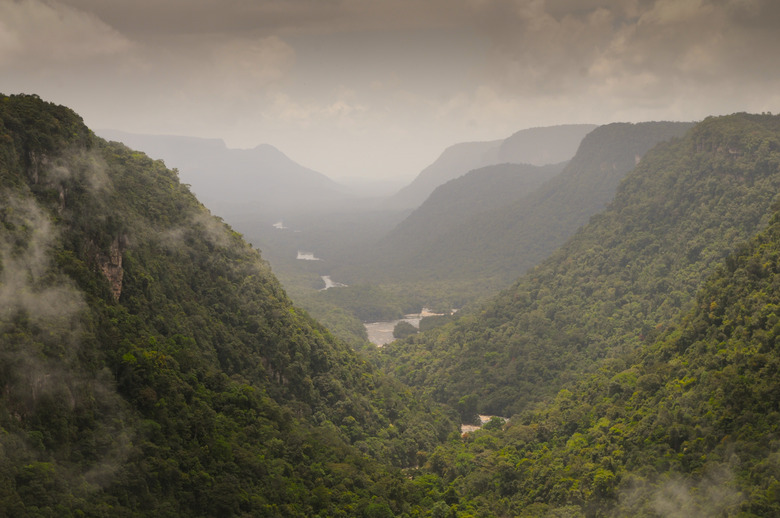The Ecosystem Of The Amazon Rainforest
The Amazon is a tropical rainforest ecosystem that encompasses the vast Amazon River drainage basin. The Amazon ecosystem covers eight countries, is approximately the size of the lower 48 United States and represents the largest continuous tract of tropical rainforest in the world.
With an average year-round temperature of 25 degrees Celsius (77 degrees Fahrenheit) and with regular heavy rainfall, it creates a warm, humid environment that has evolved an incredible diversity of plants, animals and fungi. The Amazon rainforest is an essential jungle ecosystem and has been called "the lungs of the planet" for the large amounts of oxygen produced there, yet the Amazon faces many challenges such as clearing for development and climate change.
Structure of the Rainforest
Structure of the Rainforest
A mature section of rainforest will contain several different structural levels, each containing distinct habitat niches that attract various types of organisms. Up in the canopy among the leaves and branches, monkeys and birds such as parrots, macaws and toucans travel from tree to tree, searching for fruit and making their nests.
Lower down where the branches meet the tree trunk, mosses, orchids and epiphytic plants – which grow on other plants and draw their water from moisture in the air – create a habitat for insects, birds and frogs that live in pools of water within the damp vegetation.
On the forest floor, peccaries and tapirs are hunted by the jaguar, while ocelots, jaguarundis and other predators prey on smaller mammals, reptile and amphibians that live in the shrubs and leaf litter. In the swamps live capybaras, caimans and anacondas, and in the mighty Amazon river are pink dolphins and giant otter along with a large diversity of fish.
Diversity in the Rainforest
Diversity in the Rainforest
Tropical rainforests, along with coral reefs, are the most biodiverse ecosystems on Earth, and the Amazon rainforest contains more species than any other rainforest. It is not known exactly how many species live in the Amazon, but there are estimated to be over 16,000 tree species and several million insect species, most of which are still unknown to science.
Indigenous humans also played a big part in shaping the diversity of the rainforest, by transporting and planting seeds of desirable plants to create a thriving "food forest" that provides food throughout the year. Through these methods, they have sustainably survived in the rainforest for thousands of years.
Rainforest Products and Other Values
Rainforest Products and Other Values
The rainforest produces a wide range of materials and food. Rainforest timber is high-quality and in demand, which unfortunately leads to excessive and illegal timber extraction. A huge variety of food is sourced from the rainforest, including well-known foods such as Brazil nuts and acai berries, and also fruits, vegetables, fish and honey. Additionally, many medicinal compounds have been developed from compounds found in the plants, fungi and soil organisms of the rainforest, with potentially many more to discover.
The Amazon rainforest ecosystem also plays an essential role in regulating climate and providing vital ecosystem cycling services. In this role, it produces significant amounts of oxygen, acts as a carbon sink to remove carbon dioxide from the air and stores it in the soil, and cleans huge volumes of water.
The rainforest even forms its own climate, with plants respiring water during the heat of the day to create clouds, which then flow through the atmosphere to fall as rain in other areas. This system transports so much moisture it is referred to as a flying river and has its own system of patterns and currents.
Tourism is another substantial value, with people traveling from all over the world to learn about the indigenous cultures of the region and to experience the wonders of intact and wild rainforest with giant trees, splashing waterfalls, diverse wildlife and colorful orchids.
Threats to the Rainforest
Threats to the Rainforest
Approximately 20 percent of the Amazon rainforest has already been lost to deforestation. Rainforest clearing occurs for multiple reasons, with the main culprit being clearing for agriculture. Large areas are being converted into fields of soybeans or grass for raising cattle.
Another rainforest threat is timber harvesting, both legal and illegal, which not only targets large, mature trees but also creates numerous tracks and other damage when removing the trees. Mining is also responsible for huge damage, not only in clearing the forest but by using toxic chemical waste, which then affects surrounding areas.
Many animal species, especially birds, are affected by hunting from humans. A lot are killed for food, but jaguars may be shot for their pelts or colorful birds taken for their feathers. Young birds and monkeys may be captured for the illegal pet trade.
Climate change is also a significant threat to the Amazon rainforest. A changing climate will stress ecosystem structure and resilience, intensifying impacts from other activities and making it even less adaptable in the future.
References
Cite This Article
MLA
Michelle, Meg. "The Ecosystem Of The Amazon Rainforest" sciencing.com, https://www.sciencing.com/ecosystem-amazon-rainforest-6495612/. 30 September 2021.
APA
Michelle, Meg. (2021, September 30). The Ecosystem Of The Amazon Rainforest. sciencing.com. Retrieved from https://www.sciencing.com/ecosystem-amazon-rainforest-6495612/
Chicago
Michelle, Meg. The Ecosystem Of The Amazon Rainforest last modified August 30, 2022. https://www.sciencing.com/ecosystem-amazon-rainforest-6495612/
